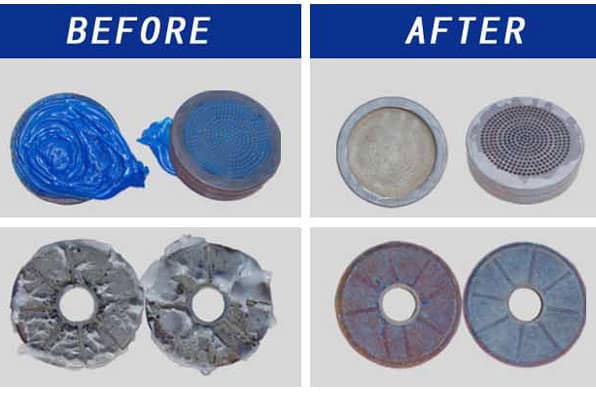Introduzione
In today’s polymer manufacturing and processing industry, Polymer Cleaning Technology has become a critical factor in ensuring product quality, improving production efficiency, and meeting environmental standards. With advancements in materials science, the application fields of polymer products continue to expand, placing increasingly higher demands on cleaning technologies.
This article provides a comprehensive analysis of the latest developments in modern polymer cleaning technologies, including innovative methods such as mechanical cleaning, chemical cleaning, and ultrasonic treatment, helping you select the most suitable solutions for your production needs.
1. Why is Polymer Cleaning So Important?
Polymer materials are prone to accumulating various contaminants during processing:
- Mold release agent residues
- Processing aids and additives
- Thermal degradation byproducts
- Environmental dust and particles
- Cross-contamination substances
These contaminants can lead to:
⚠ Surface defects in products
⚠ Reduced mechanical properties
⚠ Difficulties in secondary processing
⚠ Shortened product lifespan
2. Comparison of Mainstream Polymer Cleaning Technologies
(1) Mechanical Cleaning Technology
Applicazioni: Removing surface-adhered particles and loose contaminants
- Vacuum suction systems: Efficient dust and debris collection
- Sandblasting: For molds and heavy contamination removal
- Brush cleaning systems: Gentle treatment of sensitive surfaces
Advantages: No chemical residues, simple operation
Limitations: Difficult to remove stubborn contaminants
(2) Chemical Cleaning Technology
Applicazioni: Dissolving oils, release agents, and other organic residues
- Solvent cleaning: Fast and effective, but VOC emissions must be considered
- Aqueous cleaners: Eco-friendly option, requires heating
- Supercritical CO₂ cleaning: No residues, high equipment costs
Advantages: Excellent deep-cleaning results
Limitations: Waste liquid disposal required, may affect material properties
(3) Ultrasonic Cleaning Technology
Applicazioni: Precision components and complex geometries
- Frequency selection (20-400kHz)
- Used with specialized cleaning agents
- Suitable for small precision parts
Advantages: Thorough cleaning, high efficiency
Limitations: Not suitable for large components
(4) Plasma Cleaning Technology
Applicazioni: Surface modification and ultra-fine contaminant removal
- Low-temperature plasma treatment
- Can alter surface energy to improve subsequent processing
- No chemical reagents required
Advantages: Nanoscale cleaning, eco-friendly
Limitations: Highly specialized equipment
3. Cutting-Edge Innovations in Polymer Cleaning Technology
(1) Laser Cleaning Technology
- Non-contact processing
- Precise control of cleaning depth
- Suitable for heat-sensitive materials
(2) Bioenzyme Cleaners
- Designed for biodegradable polymers
- Gentle yet effective
- Fully biodegradable
(3) Nanobubble Technology
- Enhanced cleaning with ultrafine bubbles
- Significant water savings (up to 50% reduction)
- Currently in industrial promotion phase
4. How to Choose the Right Cleaning Technology?
| Consideration | Mechanical | Chemical | Ultrasonic | Plasma |
|---|---|---|---|---|
| Initial Investment | Low-Medium | Medium | Medium-High | High |
| Costi operativi | Low | Medium-High | Medium | Medium-High |
| Cleaning Effect | Surface | Deep | Complex Shapes | Nanoscale |
| Eco-Friendliness | Excellent | Medium-Poor | Good | Excellent |
| Suitable Scale | Large-Medium | Large-Medium | Small-Medium | Small |
Selection Advice:
- Evaluate contaminant type and adhesion level
- Consider post-processing requirements
- Calculate total cost of ownership (TCO)
- Ensure compliance with environmental regulations
5. Industry-Specific Solutions
(1) Medical Polymers
- Requirements: Sterile, pyrogen-free
- Recommendation: Plasma + supercritical CO₂ combination
(2) Automotive Components
- Requirements: Complete removal of release agents
- Recommendation: Aqueous cleaning + ultrasonic assistance
(3) Electronic Encapsulation Materials
- Requirements: No static, no particles
- Recommendation: Anti-static vacuum + laser cleaning
6. Future Development Trends
- Smart cleaning systems: AI-powered real-time monitoring
- Green chemistry: Bio-based cleaner development
- Dry cleaning technologies: Reduced water consumption
- Modular designs: Adaptable to various polymer types
Conclusione
Polymer Cleaning Technology is undergoing rapid innovation, offering businesses more efficient and eco-friendly solutions. Selecting the right cleaning method can significantly enhance product quality, reduce production costs, and meet increasingly stringent environmental requirements.
📌 Need professional advice? Our materials science team can provide customized cleaning solution evaluations.

